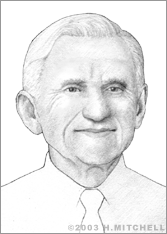Merton Flemings
Metallurgist and inventor Merton C. Flemings was born on Sept. 20, 1929 in Syracuse, New York. He first became intrigued with science in high school, inspired by a physics teacher. His research has focused, for more than 50 years, on ways to produce, recycle, and improve products through understanding and applying the underlying science of the materials those products are made of.
Flemings received his SB degree from the Massachusetts Institute of Technology (MIT) in the Department of Metallurgy in 1951, followed by his SM and ScD degrees in Metallurgy in 1952 and 1954. He accepted a position as an assistant professor at MIT in 1956 and became professor there in 1969. A decade later, he established MIT’s Materials Processing Center, where he served as director until 1982. That year, he was promoted to Department Head of Materials Science and Engineering.
Flemings holds more than 26 patents for metallurgical processes. His most notable inventions are two processes now widely used in industry. The first is the process of using magnetic fields to improve the quality of silicon single crystals and of steel continuous castings. When a conductor moves in a steady DC magnetic field, it creates a current. Since one can’t create something from nothing, there is a force acting on the conductor to produce the electricity needed to push the conductor. Otherwise, it would slow down and eventually stop. This is the basis of the electric generator. A liquid conductor acts just like the conductor in a generator: If a liquid is moving in a magnetic field, a current is generated and the flow slows down. Flemings’ patent, which is based on this phenomena, is now widely used in the growth of silicon crystals and in continuous casting of steel to control the material flow, which results in a higher quality material.
Flemings’ second process produces and forms metals in the semi-solid state. It is used to produce high quality lightweight aluminum components for cars. To use an analogy, when making ice cream, one stirs the liquid while it crystallizes in order to break up the large ice crystals that would otherwise form. When properly stirred during its manufacturing, ice cream is smooth and creamy and will keep its shape but can easily be formed – if it is not too cold. It flows smoothly as one eats it, in spite of the fact that it contains a substantial fraction of solid. Metals behave the same way. This is the basis for Flemings’ "semi-solid" patents, which are applied in making high-quality aluminum components for automobiles. The parts have greater strength and reliability than do parts made by traditional processes.
Over the course of his career, Flemings has received numerous medals, awards, and honors, including the Acta Metallurgica J. Herbert Holloman Award in 1997 and election into the National Academy of Engineering and the American Academy of Arts and Sciences. Flemings authored or co-authored 300 papers and two books, and in 2002, two chairs in the Department of Materials Science and Engineering were named in his honor: The Merton C. Flemings-SMA Professorship and The Merton C. Flemings Career and Development Chair.
Currently, Flemings is MIT’s Toyota Professor Emeritus of Materials Processing. Flemings is also on the board of cellist Yo-Yo Ma's inventive "Silk Road Project" and continues to work with industry on metal casting innovations.


